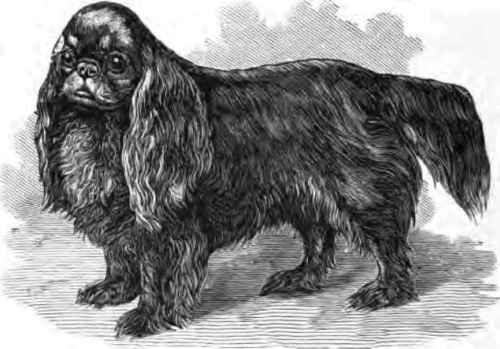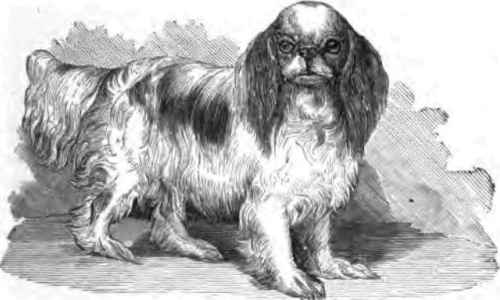Toy Spaniels
Description
This section is from the book "The Dogs Of Great Britain, America, And Other Countries. Their Breeding, Training, and Management in Health and Disease", by John Henry Walsh (Stonehenge). Also available from Amazon: The Dogs Of Great Britain, America And Other Countries.
Toy Spaniels
Two breeds are known and recognized under this head, namely, the King Charles and the Blenheim spaniels, the former being slightly the larger of the two, and by most people considered the more handsome. To an ordinary observer the chief points of distinction in the King Charles are, the color, which is black and tan more or less mixed with white, the less the better; and the length of the ears, which is greater than in the Blenheims; these being also lighter in frame, and always yellow or red and white. Both are small delicate dogs, and though they have pretty good noses, and will hunt game readily, yet they so soon tire that they are rarely used for the purpose, and are solely kept for their ornamental properties. They make good watch dogs in-doors, barking at the slightest noise, and thus giving notice of the approach of improper persons Though they are somewhat timid they are not readily silenced, as their small size allows of their retreating beneath chairs and sofas from which asylum they keep up their sharp and shrill note of defiance The great objection to these handsome little creatures as pets is that they follow badly out of doors, and as they are always ready to be fondled by a stranger, they are very liable to be stolen.
Hence many people prefer the toy terrier, or the Skye, which is now introduced very extensively as a toy dog, and might with propriety be inserted under this chapter. The King Charles and Blenheim spaniels are often crossed, and then you may have good specimens of each from the same litter, but if true, their colors never vary.

Fig. 34. - KING CHARLES SPANIEL, YOUNG JUMBO.
The points of the King Charles spaniel are: extremely short muzzle, which should be slightly turned up; black nose and palate; full prominent eye, which is continually weeping, leaving a gutter of moisture down the cheek; a round bullet-shaped head, with a well-marked "stop" between the eyes; very long, full-haired, and silky ears, which should fall close to the cheeks, and not stand out from them; the body is covered with wavy hair of a silky texture, without curl; and the legs should be feathered to the toes, the length and silkincss of this being a great point; tail well feathered, but not bushy; it is usually cropped; the color should be a rich black and tan, without a white hair; but those m irked with an unusual amount of white are not to be despised. They sometimes make their appearance in a litter of which both sire and dam have scarcely a white hair; the weight should never exceed 6, or at the utmost 7 lbs.; and they are valued the more if they are as low as 4 1/2 or 5 lbs. (See portrait.)

Fig. 35. - BLENHEIM SPANIEL.
The points of the Blenheim vary very little from those of the King Charles, except in color, which is always a white ground with red or yellow spots or patches, with well-marked blaze of white between the eyes. The ears should be colored, and also the whole of the head, with the exception of the nose and a white mark up the forehead, as is shown in the cut, which represents the Blenheim pretty accurately. The palate is black, like that of the King Charles; and there is little difference in shape, though an experienced eye could detect the one from the other even irre spective of color. This dog is generally smaller than the King Charles.
Continue to:


